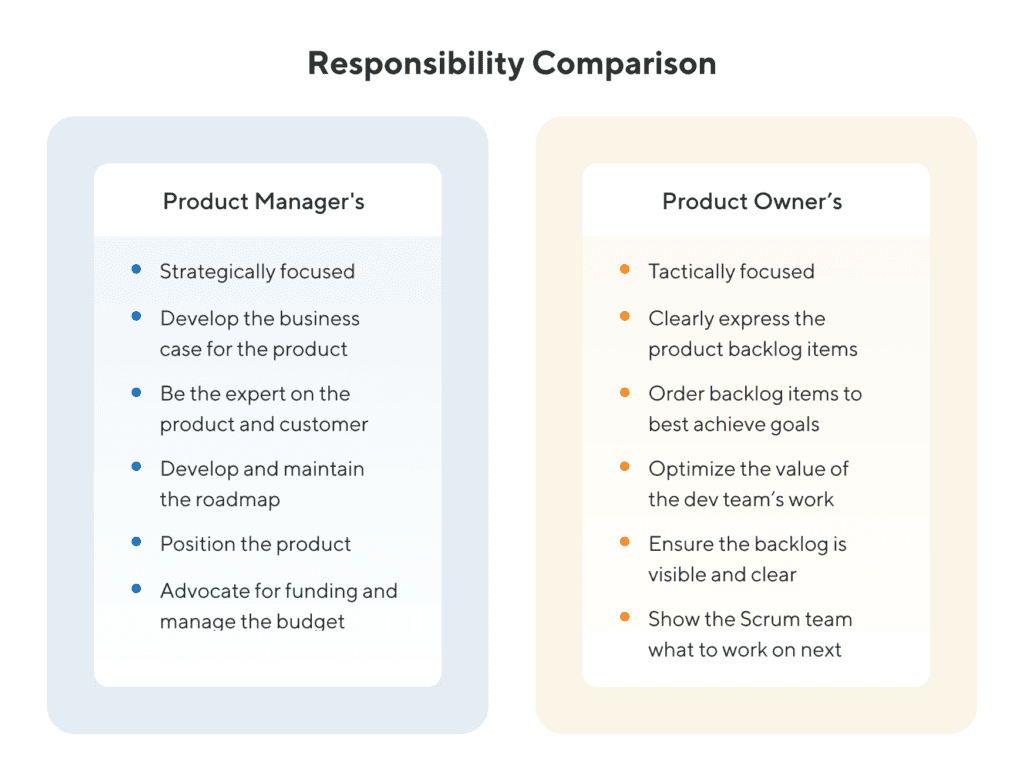What is the difference between a product manager and a product owner? The terms are often used interchangeably, and admittedly there is some overlap. However, the roles of product manager and product owner are indeed different. Today we’ll look at the role of a product owner vs. that of a product manager and explore the various skills and responsibilities.
At the highest level, there are several competing definitions for product managers and product owners. But to the extent that any consensus exists about the fundamental difference between product managers and product owners, it is this:
- Product managers are strategic. They focus on the product’s vision, company objectives, and the market.
- Product owners (which you’ll find typically in agile organizations) are more tactical. They translate the product manager’s strategy into actionable tasks and work with cross-functional agile teams to execute those requirements.
This article will delve into each of these roles and examine the similarities and differences between them.
Product Manager Role Definition
Product management is strategically driving the development, market launch, and continual support and improvement of a company’s products. A product manager’s role focuses on long-term strategy, the product vision, market trends, and the identification of new opportunities.
The education site Disciplined Agile Delivery (DAD) offers helpful definitions of product managers and product owners, which we will summarize here.
DAD describes the role of the product manager as strategic in practice and “focused on the long-term vision for the product, on observing trends in the marketplace, on identifying new potential outcomes or themes to be supported by the product, on supporting the sales/adoption of the product, and on ensuring the product meets the needs of the value stream(s) the product is involved with.”
The DAD site also describes the product manager as typically being involved in:
- Product marketing
- Supporting product sales
- Budgeting
- Long-term envisioning
- Customer care
- Supporting the solution-delivery team
Product Owner Role Definition
As product management expert Roman Pichler explains of the product manager-product owner distinction, the product owner role traces back to the Scrum agile methodology for project management. As a result, product owners today are found primarily in organizations that use the agile development approach.
Here is how DAD’s product managers vs. product owners page describes the product owner role: “Product owners are more tactical in practice,” and they “work closely with delivery teams to ensure they build the right functionality promptly. POs will transform the high-level vision of the product manager into detailed requirements. To do this, they work closely with a range of stakeholders for the product, including non-customer stakeholders such as finance, security operations, support, audit, and others.”
The DAD page explains that product owners carry out their responsibilities through tactical activities such as:
- Attending team coordination meetings
- Organizing demos
- Doing sufficient analysis to ensure requirements are ready to be worked on
- Being involved with ongoing testing efforts
Is a Product Manager the Same Thing as a Product Owner?
As Roman Pichler argues, the product owner is a product management role. However, he also points out that smaller and younger organizations—particularly in the software industry—can bring in a product owner to more quickly establish a role responsible for the product’s development without having to build out a product management team. But in the longer term, Pichler suggests, these organizations should also create a separate role for a product manager.
So, in short, product owners and product managers are not simply the same under different names. Instead, they are two unique functions.

Some organizations, often due to lack of resources, might have a product owner who also takes on the more strategic responsibilities of a product manager. Still, as the DAD page describing PMs and POs points out, each of these roles has its different focus, and each also represents a full-time job.
As the product management consulting and training company 280 Group explains on its Product Manager-Product Owner Comparison page, here is an excellent high-level overview of the different responsibilities of each role:

As you can see, there are some similarities between these functions. For example, both roles guide the product through the development process and work with several of the same teams across the organization.
Indeed, as the 280 Group explains, in some cases, a PO might take on some of the more strategic roles of a PM, and vice versa. But in a prototypical agile organization, the team will have both product owners and product managers, each responsible for some variation of the functions listed above.
In that sense, you can think of a product owner as a type of product manager—more tactical, more internal-facing—who helps keep the product’s progress on track in an agile organization.
What Skills Does a Product Owner Need?
As we explain in the What Is a Product Owner?, an effective product owner (particularly in an agile development organization) needs outstanding communication skills.
This is because a major part of a product owner’s job is translating a product manager’s high-level vision for a product into actionable tasks. As a result, product owners are key point people for developers, QA staff, UI, UX, and designers.
This is why we would argue product owners need to have several of the broader skills required of every product manager, such as communicating clearly to several different types of professionals and excellent listening skills.
Can a Product Owner Also Be a Product Manager?
The short answer is yes: A product owner can be a product manager and vice versa.
As Produx Labs CEO Melissa Perri puts it in her Product Manager vs. Product Owner article, “As a product manager your roles and responsibilities will change depending on your context and the stage of your product,” and that “Product owner is a role you play on a Scrum team. Product manager is the job.”
In other words, although the Disciplined Agile Delivery organization and the 280 Group both break out the clear division of responsibilities between these two roles, the reality is that there is also overlap among them. Thus, a single person could theoretically perform both functions simultaneously.
As Roman Pichler argues, this often happens with software startups that are not yet ready organizationally or financially to hire both.

What’s the Real Difference Between a Product Owner vs. a Product Manager?
The debate over where a product manager’s role ends and a product owner’s begins—or whether or not these two functions are just two different aspects of the same position—will probably go on forever.
However, what is essential is that your product organization has a team structure that works for your process and that the Product Managers and the Product Owners in your team know exactly what the responsibilities and goals are for their roles.



